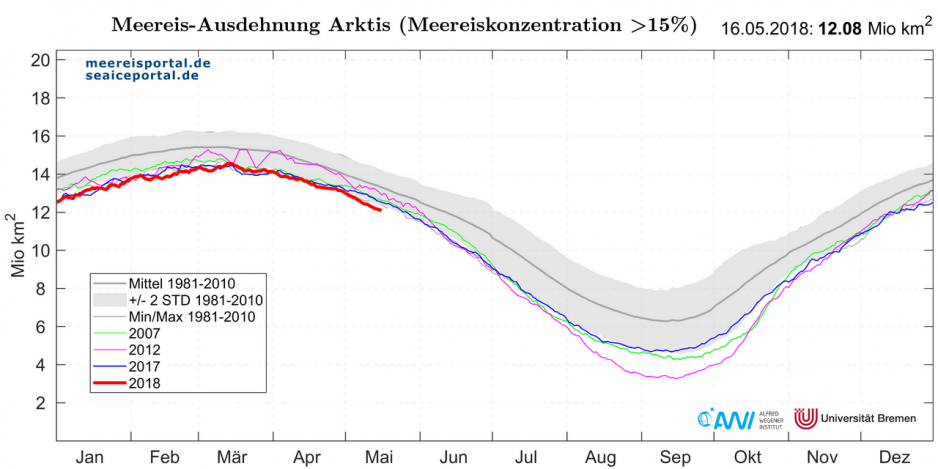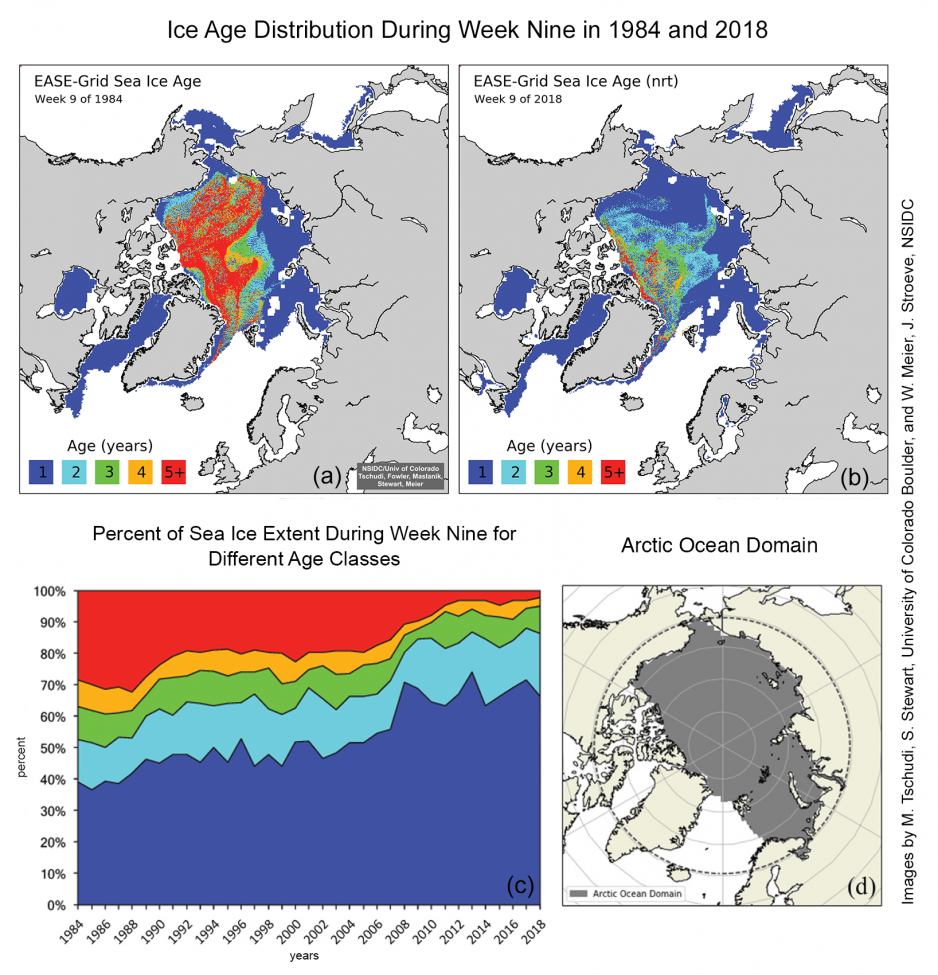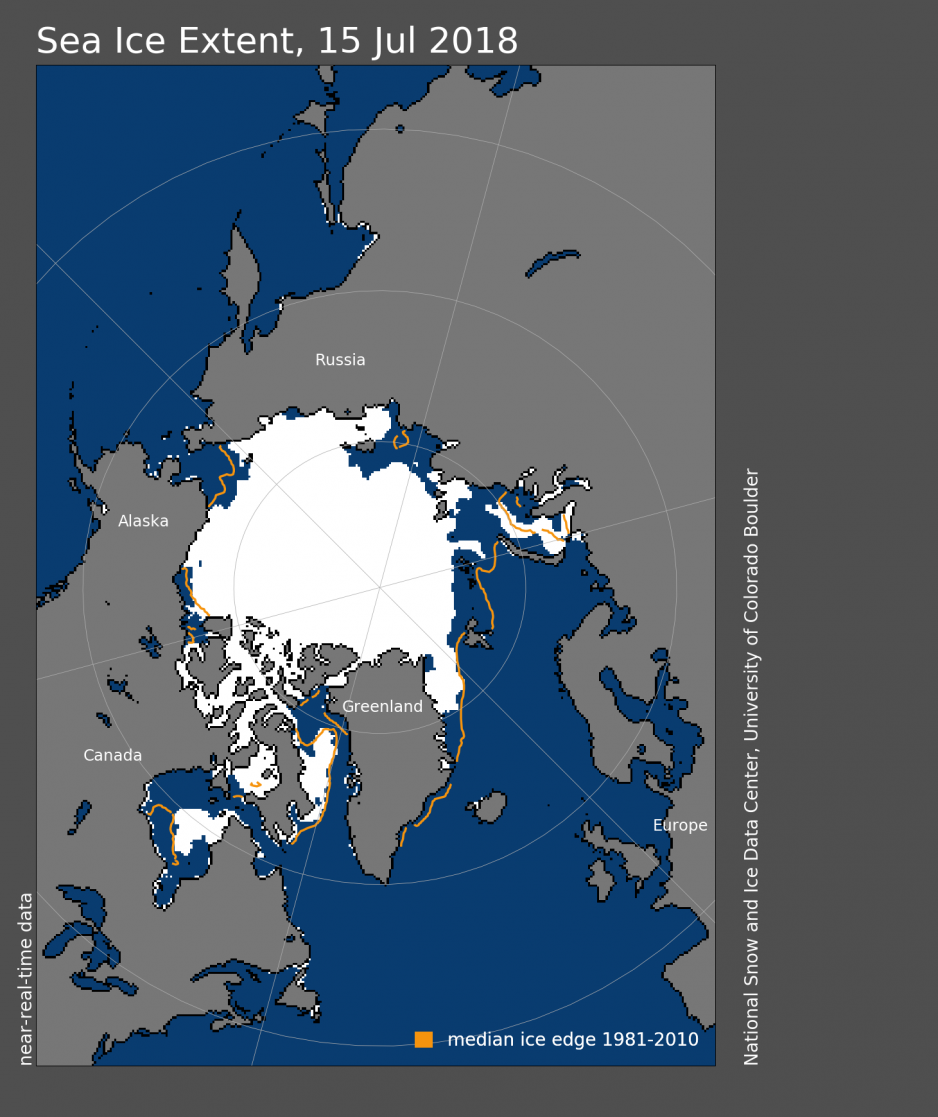Very low Spring ice but no new record summer minimum

With half the year over, Arctic sea ice extent continues on historically low levels also in 2018.
With 14.48 million square kilometres, March 2018 sea ice extent was only slightly above the 2017 extent, which was the lowest ever recorded winter maximum with 14.42 million square kilometers. Ice extends on both the Atlantic and the Pacific side of the Arctic remained unprecedentedly low; according to the National Snow & Ice Data Center (NSIDC) at the University of Colorado, Boulder.
The four lowest seasonal maxima have all occurred during the last four years.
April 2018 tied with 2016 for the lowest April sea ice extent on record with 13.7 million square kilometers. Low extends were especially pronounced in the Bering and Barents Sea, with the Bering Sea having seen the lowest recorded level since 1979, according to the NSIDC.
Air temperatures in April were up to 10 degrees Celsius higher than normal in the East Siberian Sea; up 5 degrees in the East Greenland Sea; and 3 degrees higher over Baffin Bay.
The last three winters have seen air temperatures at the North Pole surge above 0 degrees Celsius.
May 2018 showed the second lowest May sea ice extent at 12.2 million square kilometers and thus remained way below the standard deviation shown by models. The average temperature in Svalbard was 6 degrees Celsius above average. Open water stretched as far north as 82 degrees North at the end of the month.

June had the fourth lowest average extent in the satellite record (10.7 million square kilometres) with low extends in the Chukchi, Barents, Laptev, and East Siberian Seas as well as the Sea of Okhotsk.
Little ice in Spring
"The trend of low sea ice extends also prevails this spring", says Dr. Marcel Nicolaus, sea ice physicist at the Alfred Wegener Institute, Helmholtz Centre for Polar and Marine research in a recent press release by meereisportal.de. "The low winter and spring ice extends are a continuation of the record low ice extends during the winter season 2017/18," Dr Nicolaus explains.
Thinner ice
He adds that also the average ice thickness has remained slightly below the average of the last seven years. The NSIDC has estimated that the multiyear ice cover in the Arctic has declined from 61 percent in 1984 to 34 percent in 2018. Only 2 percent of the ice is now older than 5 years.

Impacts on Arctic communities
The late freeze-up in the Bering Sea area in winter 2017/18 together with the ensuing low ice during spring heavily impacted travel between communities in the region as well as hunting and fishing opportunities. On top, heavy storms and flooding damaged infrastructure due to the missing protection of the shorelines through shorefast ice.
Where we currently stand
In mid-July, Arctic ice extent was at 8.5 million square kilometres. While still below the 1981-2010 average, it is also 670,000 square kilometers above the record low from 2011. Although total Arctic sea ice extent was tracking at record low levels during winter, and although heat warnings have been issued for parts of the Arctic like in Finnish Lapland and massive forest fires rage (also in Northern) Sweden, the rate of summer ice loss thus far shows no signs of a new record minimum. Most ice has melted in the Kara Sea while in the Beaufort Sea, the ice edge has even expanded slightly southwards, according to the NSIDC.

The summer forest fires in Siberia could, however, enhance melt rates in the Arctic, according to the NSIDC, since deposition of dark smoke particles on bright ice surfaces decreases the reflectivity of the ice, thus increasing the amount of solar energy absorbed by the ice.
Where are we heading for the September 2018 ice minimum?
The Sea Ice Prediction Network publishes the Sea Ice Outlook report, which collects various predictions for the September sea ice minimum. The median June Outlook value for the September 2018 sea ice extent projection in the Arctic is 4.6 million square kilometers. This would be a similar level than 2017; still above the record minimum from 2012 at 3.4 million square kilometers; but significantly lower than the 1981 to 2010 median extent.

Geographically speaking, most predictions are certain about ice free conditions during summer in the Chukchi Sea and along the coast of Alaska. Models show more variety as to the ice conditions in the Laptev and the East Siberian Sea, with some predictions showing a low sea ice concentration while others show high levels of ice.
